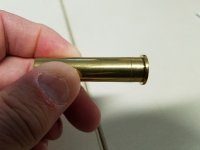fightthenoise":395d8ttt said:ShadeTree":395d8ttt said:I also agree with several on here that are thinking it's possibly a scratch......doesn't quite look right for separation, including it's a little far down the case, but it doesn't take long to be safe and check to be sure.
Agreed. Also for the record I did all my measurements above on a full length sized case because I don’t keep any factory ammo on hand. Could the die reflect the excess head space or is it definitely the chamber? I was thinking of just buying a no-go gauge but it’s such a one time tool for a caliber I only plan to have one of.
Sent from my iPhone using Tapatalk
Depends on how you set up your FL die. If it’s screwed down too far it creates more head space.
You can rent a go/no go from 4D Reamer Rentals. I’ve had good luck with his stuff and the rates are reasonable. I’ll bet a dollar to a dog turd that your headspace is good though. [emoji1]






